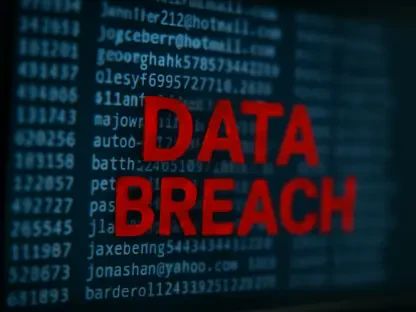In a dramatic turn of events within the cybercrime realm, the notorious LockBit ransomware gang has experienced a significant breach as an unidentified adversary recently hacked into their network, resulting in the leak of critical operational data. This development has captured the attention of cybersecurity experts and law enforcement agencies worldwide, as it raises crucial questions about the stability and security of criminal syndicates operating in the digital domain. LockBit, known for its Ransomware-as-a-Service (RaaS) model, has been dealt a severe blow as their internal data is exposed. The breach signals potential vulnerability within their networks, affecting their reputation and operational efficacy amid heightened pressure from law enforcement agencies and cyber rivals. The leak might provide valuable insights into their tactics and operations, offering a rare glimpse into how these sophisticated cybercriminal organizations function and how they may be more effectively combated in the future.
The Security Breach Unveiled
LockBit’s Dark Web leak site began showing evidence of this breach on May 7, when security researchers observed unusual changes. The site, typically featuring victim organization details, was transformed to display an unexpected message: “Don’t do crime CRIME IS BAD xoxo from Prague.” This message accompanied a link to a zip archive containing a wealth of data, as analyzed by cybersecurity firms such as Qualys. The archive revealed a SQL database file from LockBit’s affiliate panel, comprising comprehensive internal data about their RaaS operations. This data includes nearly 60,000 Bitcoin addresses and more than 4,000 chat logs with victim organizations, covering a period from December 2024 to April 2025. Moreover, it also exposes information about over 70 LockBit administrators and affiliates, including their plaintext passwords and customized configurations for the LockBit ransomware. Notably absent, however, were any decryptors or private keys, which would have further compromised the gang’s cryptographic operations and financial foothold in the cybercrime market.
The exposed database not only surfaces extensive details about their victims but also highlights intriguing operational patterns. For instance, a significant proportion of their targets during this time frame hailed from the Asia Pacific region, while relatively fewer came from North America. A shift in their ransom demands is also apparent, averaging under $20,000 during this period, significantly lower than previous demands that often reached into the millions. These findings suggest possible changes in LockBit’s geographical focus and financial strategy amidst ongoing challenges, potentially influenced by prior setbacks such as those encountered during Operation Cronos. These emerging dynamics underline a palpable transition in their mode of targeting and executing ransomware activities as they adapt to evolving pressures within a competitive and risky landscape.
Impact on LockBit’s Operations
The repercussions of this breach are expected to resonate throughout LockBit’s operations, striking at the core of their infrastructure. This incident is not an isolated event. Similar compromises have occurred recently with other ransomware groups, such as Everest, which also displayed the same warning message on their platforms. This suggests a potential coordinated effort to undermine the operations of such cybercrime groups, focusing on exposing vulnerabilities and sowing distrust within their ranks. The data leak offers unprecedented insights into their strategic approaches and target selection methodologies. It reveals that LockBit, like other ransomware gangs, often exploits vulnerabilities in backup and Network Attached Storage (NAS) systems, which are critical for data recovery and protection. By targeting these systems, they ensure maximum disruption, causing victims to consider ransom payouts to prevent significant data loss.
The examination by Qualys and other cybersecurity entities further underscores how LockBit leverages software vulnerabilities to gain access and deploy ransomware efficiently. The gang’s particular focus on Veeam backup software exploits highlights a common strategy used by ransomware operators to bypass security measures. This persistent tactic of disabling defense mechanisms, including security and recovery agents, enhances their ability to encrypt data and prevents any potential recovery, thus tightening LockBit’s grip on compromised networks. Such intricate methodologies reveal the advanced level of technical expertise utilized by LockBit in its operations, contributing to its previous success and notoriety in the cybercrime arena. However, the exposure of these techniques now equips security professionals with vital information and opportunities to bolster defenses against similar attacks in the future.
Implications and Strategic Insights
On May 7, LockBit’s Dark Web leak site revealed an unusual breach, as security researchers noticed unexpected changes. Typically featuring details about victim organizations, the site displayed a message: “Don’t do crime CRIME IS BAD xoxo from Prague,” alongside a link to a zip archive filled with internal data. Cybersecurity experts at Qualys analyzed the archive, discovering a SQL database file from LockBit’s affiliate panel. This file contained extensive details about their Ransomware-as-a-Service (RaaS) operations, such as 60,000 Bitcoin addresses and over 4,000 chat logs from December 2024 to April 2025. Additionally, the database exposed details about more than 70 LockBit administrators and affiliates, including plaintext passwords and ransomware configurations. However, it lacked decryptors or private keys, safeguarding the gang’s cryptographic operations. The data illuminated operational patterns, showing a focus on the Asia Pacific region and an average ransom demand below $20,000, signifying a strategy shift, likely due to pressures from incidents like Operation Cronos.









